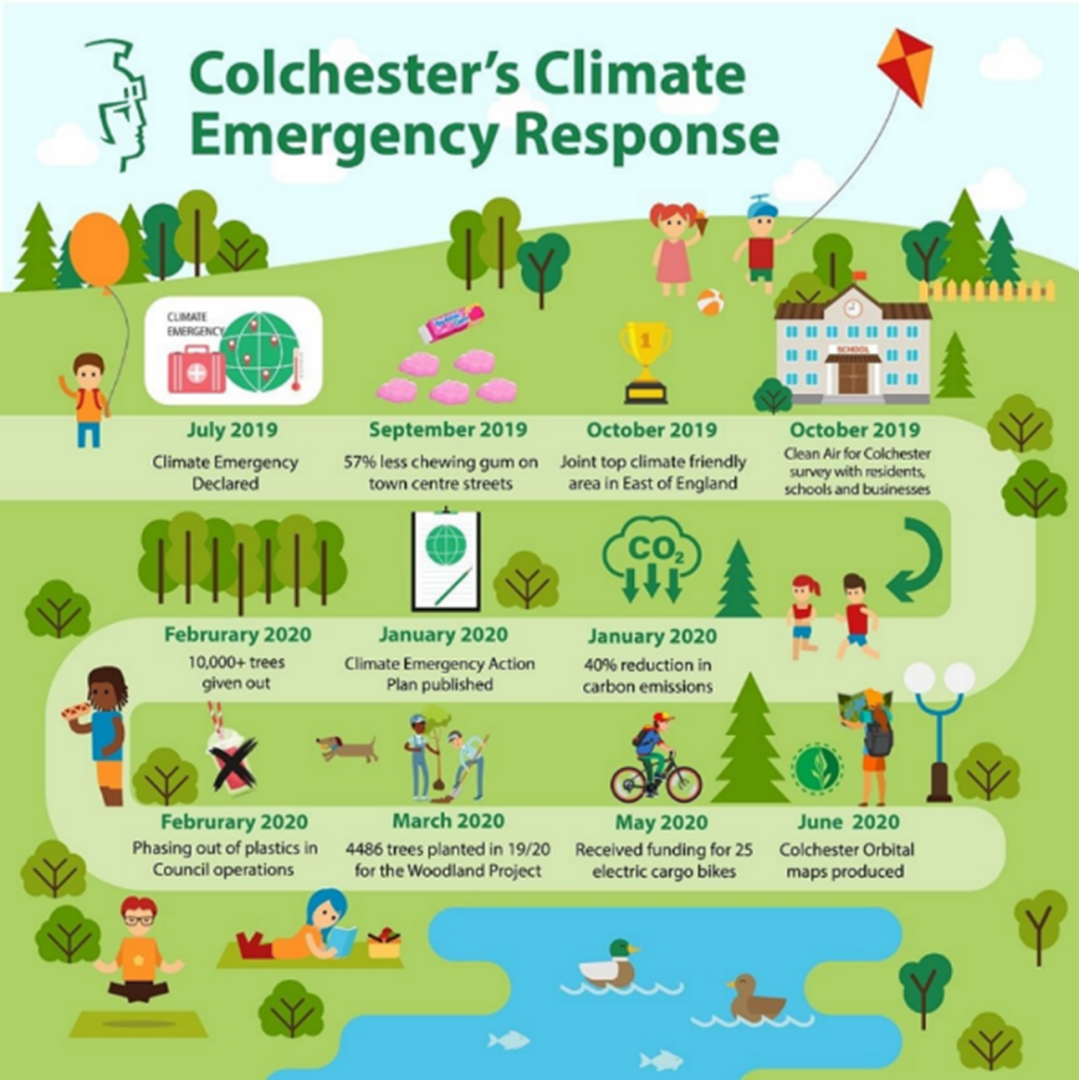Climate Change SPD
Chapter 1: Introduction
Climate change is a global issue affecting everyone. Co-ordinated action from all sectors, national and local governments, and individuals is needed to mitigate and adapt to climate change. The science tells us that to avoid catastrophic effects we need to limit the increase in global temperature to 1.5oC. Mitigation measures are required to significantly reduce greenhouse gas emissions and limit global temperature rise. However, even with efforts to limit the cause of global warming, further climatic changes are inevitable in the future and the UK will need to adapt to the growing risks from climate change.
Colchester City Council declared a climate emergency in 2019 and since then have carried out numerous pieces of work across the organisation and city to respond to the climate emergency. The infographics, below, highlight the key areas of work in 2019/20, 2020/21 and 2021/22.



The Council is drafting 3 Supplementary Planning Documents (SPDs) to communicate Colchester City Council's ambitions for all development within the city. SPDs are material considerations in planning decisions. They build on adopted planning policy and provide guidance on how policy requirements should be implemented. The 3 climate emergency SPDs build on the adopted Local Plan and explain how development proposals should respond to the climate and ecological emergency. The SPDs are: Active Travel, Biodiversity, and Climate Change. All development proposals should strive to achieve ambitious carbon reductions, biodiversity enhancement and promotion of active travel to contribute towards Colchester becoming a greener city that is resilient to the climate and ecological emergency.
We are in a climate and ecological emergency – the time to act is now.
The 3 climate emergency SPDs will bring multiple benefits including benefits to health and wellbeing. A healthy environment plays a role in improving health and wellbeing. Many of the actions proposed in the 3 SPD's will also achieve health benefits for our communities. An increase in active travel will lead to more walking and cycling. More energy efficient homes will be good for people's wellbeing and reduce heating costs. An increase in biodiversity and green infrastructure is good for people's mental wellbeing.
This is the Climate Change SPD. It aims to clearly set out the principles the Council expects to ensure that development proposals respond to the climate emergency by delivering sustainable buildings, which are highly energy efficient, include renewable energy and combine green infrastructure. This SPD is ambitious and explains how applicants can successfully integrate a best-practice approach towards the climate emergency in their development proposals.
Chapter 2 of the SPD sets out the background and context and provides a summary and links to relevant reports. Chapter 3 sets out the Colchester context. It includes relevant Local Plan policies and discusses Colchester City Council's climate emergency declaration. Chapter 4 includes guidance on Improving Layout and Building Design. Topics covered in this chapter include passive design, building orientation and massing, overshadowing, windows, building fabric and materials, ventilation and air tightness, reducing overheating, working from home space, and green-blue infrastructure. Chapter 5 provides advice on renewable and low carbon energy. The Council's ambition is that development should be fossil free and residual energy demand for heating, hot water and other uses is met from renewable or low carbon energy sources. Chapter 6 explains the LETI standard, which the Council encourages to achieve net zero carbon buildings. The LETI standard of net zero carbon includes energy use targets rather than a reduction in emissions. Chapter 7 includes advice on electric vehicle charging, which is included in the Essex Design Guide. Reducing the risk of drought is crucial in adapting to a changing climate and chapter 8 sets out water efficiency measures that the Council encourages. Chapter 9 provides advice for householder applications.
There is a wealth of information, guidance, toolkits, and best practice available. This SPD does not attempt to distill all this information and guidance into one document. Links are provided throughout the SPD to more detailed guidance for those who want to read more.
